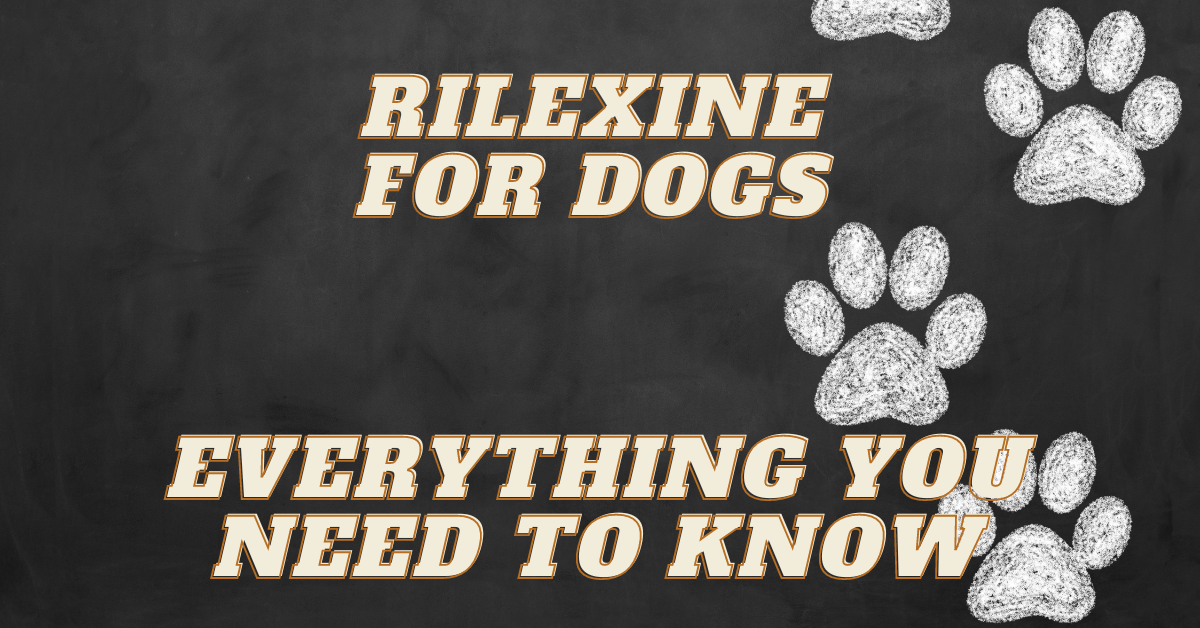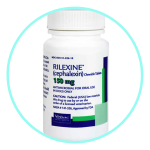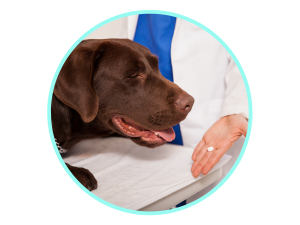





Rilexine for dogs is the go-to option a veterinarian will administer when a dog comes down with a bacterial infection. The antibiotic is often used to treat two types of infections – skin inflammation and bacteria in the urinary tract.
At AvenueDogs.com, we are committed to helping pet owners sort through specific medications that may (or may not) be suitable. Today we’re going to discuss a popular vet-approved antibiotic that’s designed for your pup. If you’re considering Rilexine for dogs, you’re in the right spot.
If you’d rather listen to this blog, just click play on the YouTube video below:
If you’d like to know more about home medications that can help your pet, check out our vet-approved list below:
| Dyne for Dogs: For Energy & Weight Gain | Omeprazole for Dogs: For Ulcers & Inflammation | Enrofloxacin for Dogs: For Bacterial Infections |
Cefpodoxime for Dogs: For Bacterial Infections | Sucralfate for Dogs: Chronic Upset Stomach | Cosequin for Dogs: For Joint Health |
| Ursodiol for Dogs: For Liver & Gallbladder | Trazodone for Dogs: For Anxiety & Aggression | Mometamax for Dogs: For Ear Infections |
| Credelio for Dogs: For Ticks & Fleas | Chlorpheniramine for Dogs: For Allergy-Related Conditions | Butorphanol for Dogs: For Painful Coughs |
| Dinovite for Dogs: For Irritating, Itchy Coat | Dasuquin for Dogs: For Joint Health | Meloxidyl for Dogs: For Pain & Inflammation |
| Glandex for Dogs: For Digestive Support | Rilexine for Dogs: For Bacterial Infections | Enalapril for Dogs: For Cardiac Conditions |
| Quercetin for Dogs: For Allergy & Inflammation | Carprovet for Dogs: For Pain & Inflammation | Pimobendan for Dogs: For Congestive Heart Failure |
| Simplicef for Dogs: For Bacterial Infections | Clindamycin for Dogs: For Bacterial Infections |
Until then, check out some vet-approved info on Rilexine for dogs.
Top 20 FAQs for Rilexine for Dogs
There are a lot of questions surrounding Rilexine for dogs. We’ll take a quick look at the prescription medication to give you an idea about what it can (and can’t) do. We’ll then take a deeper dive into Rilexine for dogs so you can make an informed decision about whether or not it could be a good fit for your pet.



As always, the info found in this article should not replace the advice of your vet. Use this article to gain an understanding of what Rilexine for dogs is all about before talking to your veterinarian more in-depth about the medication. With that said, let’s get started!
#1 What Is Rilexine For Dogs?
Rilexine for dogs is an antibiotic specifically designed for canine use. It’s used to treat various bacterial infections, especially those affecting the skin and urinary tract.
#2 How Does Rilexine Work?
Rilexine for dogs targets and destroys harmful bacteria, preventing them from growing and reproducing, thus helping to clear up infections.
#3 Is It Safe To Give My Dog Rilexine?
Yes, when prescribed by a vet, Rilexine for dogs is generally safe. Like all medications, follow the dosage instructions and monitor for side effects.
#4 What’s The Usual Dosage Of Rilexine For Dogs?
The dosage depends on your dog’s weight and the infection’s severity. Always follow your vet’s recommendation when giving Rilexine for dogs.
#5 How Long Should My Dog Take Rilexine?
Typically, a course of Rilexine for dogs lasts 7-10 days. Always finish the full prescription, even if symptoms improve.
#6 What If My Dog Misses A Dose Of Rilexine?
If you forget a dose of Rilexine for dogs, give it as soon as you remember. If it’s close to the next dose, skip the missed one.
#7 Can Rilexine For Dogs Be Given With Food?
Yes, giving Rilexine for dogs with food can help reduce stomach upset.
#8 What Are The Side Effects Of Rilexine?
While Rilexine for dogs is generally safe, side effects can include vomiting, diarrhea, or loss of appetite. Contact your vet if you notice any adverse reactions.
#9 Can I Give Rilexine To My Pregnant Dog?
Always consult your vet before giving Rilexine for dogs to pregnant or nursing canines.
#10 What Should I Do If My Dog Has An Allergic Reaction To Rilexine?
If you suspect an allergic reaction to Rilexine for dogs, like swelling or difficulty breathing, seek veterinary attention immediately.
#11 Can Rilexine Be Used With Other Medications?
Rilexine for dogs can interact with some medications. Always inform your vet of all drugs your dog is taking.
#12 How Should Rilexine Be Stored?
Keep Rilexine for dogs in a cool, dry place, away from children and other pets.
#13 Is Rilexine Effective Against All Bacterial Infections?
No, Rilexine for dogs is primarily effective against specific bacteria. A vet will determine if it’s the right choice for your dog’s infection.
#14 What Happens If My Dog Takes Too Much Rilexine?
If you suspect an overdose of Rilexine for dogs, contact your vet or emergency clinic immediately.
#15 Why Was Rilexine Prescribed For My Dog’s Skin Infection?
Rilexine for dogs is commonly prescribed for skin infections due to its effectiveness against the bacteria that often cause these conditions.
#16 Can I Use My Other Pet’s Rilexine For My Dog?
Never use medication prescribed for another pet. Rilexine for dogs should be given as directed by your vet for that specific dog based on weight and the severity of the infection.
#17 How Quickly Does Rilexine Work?
You might see improvement in symptoms within a few days of starting Rilexine for dogs, but always complete the full course.
#18 Is Rilexine The Same As Human Antibiotics?
While Rilexine for dogs works similarly to some human antibiotics, never give human medications to dogs without consulting a vet.
#19 What Should I Do If Rilexine Doesn’t Seem To Be Working?
If there’s no improvement after a few days of giving Rilexine for dogs, consult your vet for further guidance.
#20 Why Can’t I Stop Giving Rilexine Once My Dog Feels Better?
Stopping Rilexine for dogs prematurely can allow bacteria to regrow, possibly leading to a more resistant infection. Always complete the prescribed course.



If Rilexine for dogs still sounds like it might be a good fit for you and your pet, it’s time to take a closer look at the ins and outs of the medication. At the end of this article, if you think Rilexine is potentially your best bet for your pup’s bacterial infection, consult your vet to get a prescription.
What is Rilexine for Dogs?
Rilexine for dogs is an antibiotic medication specifically designed for our canine friends. Here’s a brief rundown:



- Composition: It contains cephalexin as its active ingredient. Cephalexin is a type of antibiotic known as a cephalosporin.
- Purpose: Rilexine for dogs is primarily used to treat bacterial infections. Commonly, it’s prescribed for skin infections, urinary tract infections, and other bacterial-related conditions.
- Form: It usually comes in chewable tablet form, making it easier for dog owners to administer.
Think of Rilexine for dogs as a specialized tool in our arsenal to help our furry pals combat certain bacterial issues. It’s like giving them a little shield against those pesky bacteria!
What Does Rilexine for Dogs Do?
Rilexine for dogs acts as a defender against harmful bacteria in our furry buddies. Here’s how it works:



- Bacteria Fighter: Rilexine for dogs targets and destroys specific bacteria causing the infection. It binds to the bacteria’s cell wall, causing it to rupture and eventually die.
- Broad Spectrum: It’s a broad-spectrum antibiotic, meaning it’s effective against a wide range of bacterial strains.
- Targeted Use: While it combats various infections, it’s especially potent against skin and urinary tract infections in dogs.
So, when you give Rilexine to your dog, you’re essentially equipping them with a weapon to knock out those unwelcome bacterial invaders. It’s like sending in a special ops team to clear out the bad guys!
How Does Rilexine for Dogs Work?



Rilexine for dogs works by targeting the bacteria causing the infection in our pups. At its core, the active ingredient, cephalexin, interferes with the bacteria’s ability to form a proper cell wall.
Without a stable cell wall, the bacteria become vulnerable and eventually rupture and die. This disruption in the bacteria’s life cycle helps to clear the infection from the dog’s system. So, when you give Rilexine to your dog, it’s like sending in a microscopic cleanup crew to take care of the bacterial mess inside their body.
It’s a nifty little helper in the fight against infections!
Rilexine for Dogs Dosage
Rilexine for dogs dosage is determined based on the weight of the dog and the severity of the infection. Here’s a general idea:
- Weight-Based: Typically, the dosage is calculated in milligrams per pound (mg/lb) of the dog’s weight.
- Frequency: It’s often administered twice daily, but the exact duration and frequency depend on the type of infection being treated.
- Tablet Strengths: Rilexine comes in different strengths, like 75mg, 300mg, and 600mg chewable tablets, to accommodate dogs of various sizes.
However, following the specific dosage prescribed by a veterinarian for your dog’s unique situation is essential. Overdosing or underdosing can lead to complications or ineffective treatment. Always ensure you’re giving the right amount of Rilexine for dogs to get the best results.
How is Rilexine for Dogs Administered?
Rilexine for dogs is designed to be user-friendly for pet owners. Here’s how it’s typically given:



- Chewable Tablets: Rilexine comes in the form of chewable tablets, which many dogs find palatable. This means you can often give it to them as if it’s a treat!
- With or Without Food: It can be administered either with food or on an empty stomach. However, giving it with food can help reduce the chances of stomach upset.
- Consistent Timing: Try to give Rilexine at roughly the same times each day for best results. This ensures a consistent level of the antibiotic in your dog’s system.
Remember, while Rilexine for dogs is designed to be easy to give, always follow any specific instructions from your vet, especially regarding dosage and duration.
What if I Miss a Dose of Rilexine for Dogs?
If you happen to miss a dose of Rilexine for dogs, don’t stress too much! Here’s what you should do:



- Administer ASAP: Give the missed dose as soon as you remember.
- Don’t Double Up: If it’s close to the time for the next dose, skip the missed one. Never give two doses at once as this can increase the risk of side effects.
- Stay on Schedule: Continue with the regular dosing schedule after that. Consistency is key to ensuring the antibiotic works effectively.
Mistakes happen, and we all forget sometimes. The important thing with Rilexine for dogs is to get back on track and ensure your pup gets the full course of treatment.
Does Rilexine for Dogs Require A Prescription?




Yes – Rilexine for dogs does require a prescription. It’s not an over-the-counter medication. Veterinarians prescribe Rilexine after evaluating the dog’s condition and determining that this specific antibiotic is appropriate for the type of bacterial infection present. Always ensure you’re using Rilexine for dogs under the guidance of a vet to ensure the safety and health of your furry friend.
What Alternatives Are There for Rilexine for Dogs?
There are several alternatives to Rilexine for dogs, depending on the type of infection and the specific needs of your dog. Some of these alternatives include:
- Amoxicillin: A commonly used antibiotic for a variety of infections in dogs.
- Clavamox: A combination of amoxicillin and clavulanic acid, often used for skin and soft tissue infections.
- Baytril (enrofloxacin): An antibiotic that’s effective against a broad range of bacteria, often used for respiratory and urinary tract infections.
- Ciprofloxacin: Another antibiotic option, especially for urinary tract infections.
- Doxycycline: Used for a variety of infections, including those caused by ticks.
While these are some of the alternatives, consulting with a veterinarian is crucial. They’ll recommend the best antibiotic based on the specific bacterial strain causing the infection and your dog’s overall health.
Always prioritize professional advice when considering alternatives to Rilexine for dogs.
When Will You See Results from Rilexine for Dogs?
When using Rilexine for dogs, you’ll typically start to see improvements in your dog’s condition within a few days. However, the exact timeline can vary based on a few factors:



- Severity of the Infection: More severe infections might take a bit longer to show noticeable improvement.
- Type of Infection: While some infections, like certain skin conditions, might show rapid improvement, others, like deep-seated urinary tract infections, might take a bit longer.
- Dog’s Overall Health: A dog with a robust immune system might recover faster, while older or immunocompromised dogs might take a bit longer.
Even if you notice improvements, completing the entire course of Rilexine for dogs as prescribed is essential. Stopping early can lead to a resurgence of the infection or contribute to antibiotic resistance.
So, while it’s heartening to see your pup feeling better, stick with the treatment plan for the best long-term results!
Rilexine for Dogs Side Effects
Rilexine for dogs, like any medication, can have potential side effects. While many dogs tolerate it well, some might experience:



- Digestive Issues: This can include symptoms like vomiting, diarrhea, or a loss of appetite.
- Allergic Reactions: Signs might be swelling of the face, hives, or difficulty breathing. If you notice these, it’s crucial to seek immediate veterinary attention.
- Lethargy: Some dogs might seem more tired or less active than usual after taking Rilexine.
- Increased Thirst and Urination: This isn’t common but can occur in some dogs.
It’s always a good idea to monitor your dog closely when starting any new medication, including Rilexine for dogs. If you observe any unusual behaviors or symptoms, it’s wise to consult with your veterinarian to ensure your dog’s safety and well-being.
Are There Any Risk Factors for Rilexine for Dogs?
Yes, there are certain risk factors to consider when administering Rilexine for dogs:



- Allergies: Some dogs might be allergic to cephalexin or other cephalosporin antibiotics. If your dog has had a reaction to antibiotics in the past, it’s essential to inform your vet.
- Kidney Disease: Dogs with kidney issues might need a modified dose or might not be suitable candidates for Rilexine, as the kidneys play a role in processing the drug.
- Pregnancy and Lactation: While Rilexine is generally considered safe for pregnant or lactating dogs, it’s always best to discuss with a vet before administering.
- Concurrent Medications: If your dog is on other medications, there could be potential interactions. Always provide a full list of medications and supplements your dog is taking to the vet.
Being aware of these risk factors ensures that Rilexine for dogs is used safely and effectively. Always prioritize your dog’s health by staying informed and consulting with professionals.
Are There Any Drug Interactions with Rilexine for Dogs?




Yes, there can be potential drug interactions when using Rilexine for dogs. Some of the notable interactions include:
- Aminoglycoside Antibiotics: Combining Rilexine with drugs like gentamicin can increase the risk of kidney damage.
- Probenecid: This drug can increase the concentration of Rilexine in the blood, potentially leading to an overdose.
- Blood Thinners: Rilexine can enhance the effects of anticoagulant drugs, like warfarin, which can increase the risk of bleeding.
- Other Antibiotics: Using Rilexine concurrently with certain other antibiotics can either diminish or enhance the effects of one or both drugs.
If your dog is on any medications, it’s crucial to inform your veterinarian. They can assess the potential for interactions and adjust dosages or choose alternative treatments if necessary.
How to Store Rilexine for Dogs
Storing Rilexine for dogs properly ensures its effectiveness and safety. Here’s how you should store it:



- Cool and Dry Place: Keep Rilexine in a cool, dry location, away from direct sunlight. A typical room temperature is usually ideal.
- Original Packaging: Retain the medication in its original container or packaging. This helps in keeping track of dosage information and expiration dates.
- Away from Children and Pets: Ensure that Rilexine for dogs is stored out of reach of children and other pets to prevent accidental ingestion.
- Avoid Moisture: Keep the bottle or container tightly closed to prevent moisture from getting in, which can degrade the medication.
By following these storage guidelines, you can ensure that Rilexine for dogs remains potent and safe for your pup when they need it. Proper storage practices are a simple yet crucial step in pet care.
Is Rilexine for Dogs Safe for All Dogs?
While Rilexine for dogs is generally safe for many dogs when prescribed by a veterinarian, it’s not suitable for every dog. Here are some considerations:



- Allergies: Dogs allergic to cephalexin or other cephalosporin antibiotics should avoid Rilexine.
- Health Conditions: Dogs with certain health issues, especially kidney disease, might need a modified dose or might not be the best candidates for Rilexine.
- Age: Very young puppies or very old dogs might metabolize drugs differently, so it’s essential to consult with a vet about appropriate dosing or alternatives.
- Pregnancy and Lactation: While Rilexine is often considered safe for pregnant or lactating dogs, it’s always best to discuss with a vet before administering.
It’s essential to have a thorough vet consultation before starting any medication, including Rilexine for dogs. The vet can assess your dog’s unique health profile and determine if Rilexine is the rig
Rilexine for Dogs Reviews
There’s no surprise that Rilexine for dogs has some pretty impressive reviews across the web. After all, it’s a prescription medication designed specifically for canine use. The vet-approved antibiotic has great success when used correctly. Here’s a quick rundown of what people like about Rilexine for dogs:



- Effective Treatment: Many dog owners have reported that Rilexine for dogs effectively treated their pet’s bacterial infections, especially skin and urinary tract infections.
- Palatable: The chewable form of Rilexine is often well-received by dogs, making it easier for owners to administer.
- Quick Results: Some users have noticed improvements in their dog’s condition within just a few days of starting the medication.
- Minimal Side Effects: While side effects can occur, many owners have found that their dogs tolerate Rilexine well, with minimal or no adverse reactions.
Specifically, one user in their Rilexine for dogs review found Rilexine to be an effective antibiotic for his Rottweiler, who had a bacterial infection that made her lethargic and depressed. After a couple of days on Rilexine, she showed significant improvement. By the third day, her high temperature had returned to a healthy range.



Final Thoughts on Rilexine for Dogs
Rilexine for dogs can be a good option for dogs that have certain bacterial infections. However, because the antibiotic is only responsive to certain bacteria, it’s a good idea to get a prescription for your pet before beginning any treatment.
That said, Rilexine for dogs is worth bringing up to your vet if you haven’t already done so. Your veterinarian will be able to assess the severity of your pup’s condition and prescribe the ideal dosage to get your dog back to optimal health.



Natasha Moore is a professional SEO content writer and owner of Word Brokers, LLC. She enjoys traveling, hanging out with pups of all sorts, and reading the biggest books she can find. She’s also a full-time digital nomad, and you can find her writing content from the beach in Mexico, a corner coffee shop in Colombia, or lounging by the lake in Guatemala.
